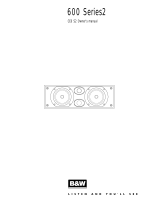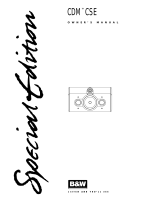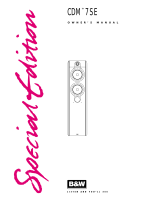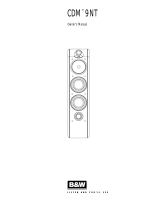Page is loading ...

DM
™
305 Owner’s manual
300 Series

Figure 1
Figure 2
Figure 3
Figure 4 Figure 5
DM™305
Owner’s manual
English ...............................1
Deutsch
.........................................2
Français........................................3
Español
.........................................4
Nederlands
..................................6
Dansk............................................7
Italiano .........................................8
Português
......................................9
>0.5m
>0.5m
>1.5m
≈≈
≈
Amplifier
DM™305

1
INTRODUCTION
Thank you for purchasing B&W DM300 Series
speakers.
Since its foundation in 1966, the continuing
philosophy of B&W has been the quest for
perfect sound reproduction. Inspired by the
company’s founder, the late John Bowers, this
quest has entailed not only high investment in
audio technology and innovation but also an
abiding appreciation of music to ensure that
the technology is put to maximum effect.
The rear panel of the DM™305 cabinet is
formed into a wedge pattern similar to the
interior of an anechoic chamber. This greatly
helps to break up the regular internal cabinet
volume that would otherwise encourage
coloration from internal standing waves.
Homogeneous fibre cone bass/midrange
drive units are used for minimum coloration
and maximum definition. The DM™305 also
features a soft dome tweeter with magnetic
fluid cooling to ensure good definition to the
limits of audibility and maintain dynamics to
high sound levels.
However, no matter how good the speakers
themselves, they must work well into the listening
room and time spent on the installation process
will reap the reward of many hours listening
pleasure. Please read through this manual fully.
It will help you optimise the performance of your
audio system.
B&W distribute to over 50 countries world-wide
and maintain a network of dedicated distributors
who will be able to help should you have any
problems your dealer cannot resolve.
UNPACKING
(figure 1)
• Fold the top carton flaps right back and invert
the carton and contents.
• Lift the carton clear of the contents.
• Remove the inner packing from the product.
• 4 spike feet and 4 lock nuts are taped in
recesses in one polystyrene end tray.
We suggest you retain the packaging for future
use.
CONNECTIONS
(figure 2)
All connections should be made with the
equipment turned off.
There are two pairs of terminals at the back of
each speaker, one pair to the bass unit and one
pair to the tweeter which permit bi-wiring or bi-
amplification if desired. On delivery, both pairs
are connected together by plated copper links
for use with a single twin cable.
Connect the positive terminal on the speaker
(marked + and coloured red) to the positive
terminal on the power amplifier and negative
(-, black) to negative (figure 2). Failure to
observe correct polarity will result in poor
sound balance and image focusing.
When bi-wiring the speakers, loosen the terminal
caps and remove the links. Use a separate twin
cable from the amplifier terminals to each pair of
speaker terminals (figure 3). Correct polarity
connection is even more critical in this case to
maintain the frequency response of each speaker
as well as the correct balance between left and
right speakers. The use of separate cables can
improve the reproduction of low-level detail by
reducing interaction in the crossover and
allowing optimum choice of cable for each
frequency range.
Always make sure all the terminal caps are
screwed down tight, as otherwise they may
rattle.
When choosing cable, keep the total electrical
impedance (out and back) below the maximum
recommended in the specification. In particular,
the cable to the tweeter should have low
inductance, otherwise the very high frequencies
will be attenuated. Ask your dealer for advice,
as the optimum cable will depend on the length
required.
POSITIONING
(figure 4)
Some experimentation with the position of the
speakers is well worthwhile to optimise the
interaction between them and the listening room.
However, as an initial guide:
Do not fit the spike feet until you have found the
best position for the speakers.
Place the speakers and the centre of the listening
area approximately at the corners of an
equilateral triangle.
Keep the speakers at least 1.5m (5ft) apart to
maintain left-right stereo separation.
Keep the speaker baffles at least 0.5m (20in)
clear of walls. Having the speakers too close
to walls increases the level of bass relative to
the midrange and may give a boomy quality
to the sound.
WARNING: The DM™305 produces a static
magnetic field that extends outside the cabinet
boundary. As such The DM™305 should not be
placed within 0.5m (20in) of equipment that
may be affected by such a field, e.g. Cathode
Ray Tubes in TVs and Personal Computers.
FINE TUNING
Before fine tuning the installation, double check
the polarity and security of the connections.
If the level of bass is uneven with frequency, this
is usually due to strong excitation of resonance
modes in the room.
Even small changes in the position of the
speakers within the listening room can have a
profound effect on the perceived sound quality
by altering the excitation of these modes. Try
mounting the speakers along a different wall.
Even moving large pieces of furniture about can
have an effect.
If the general level of bass is too high, try
moving the speakers further away from the
walls. Conversely, if you need more bass,
move the speakers closer to the walls.
Space behind the speakers also improves
the impression of perspective on well recorded
material.
If the central image is poor, try moving the
speakers closer together or toeing them in so
they point at or just in front of the listening
area (figure 5).
If the sound is too harsh, increase the amount
of soft furnishing in the room. For example, use
heavier curtains. Conversely reduce the amount
of soft furnishing if the sound is dull and lifeless.
Test for flutter echoes by clapping your hands
and listening for rapid repetitions. These can
smear the sound, but may be reduced by
irregular shaped surfaces such as bookshelves
and large pieces of furniture.
Ensure the speakers stand firmly on the floor.
Whenever possible fit the spike feet supplied
after you have optimised the positioning. These
are designed to pierce through carpeting to the
floor surface. Initially, screw the lock nuts fully
onto the spikes and screw the spikes fully into
the threaded inserts in the base of the cabinet. If
the cabinet rocks, unscrew the two spikes that do
not touch the floor equally until the cabinet sits
firmly on the floor, and lock them in place by
tightening the lock nuts against the cabinet. If
there is no carpet and you wish to avoid
scratching the floor surface, use a protective disc
between the spike and the floor.
AFTERCARE
The vinyl veneers normally only require dusting.
If you wish to use an aerosol cleaner, remove the
grille first by gently pulling it away from the
cabinet. Spray onto the cleaning cloth, not
directly onto the cabinet. The grille fabric may
be cleaned with a normal clothes brush after
removing the grille from the cabinet.
Avoid touching the drive units, especially the
tweeter, as damage may result.

Description
Drive units
Frequency range
Frequency response
Dispersion
Sensitivity
Harmonic distortion
Nominal impedance
Crossover frequency
Recommended
amplifier power
Max. Recommended
Cable impedance
Dimensions
Net weight
DM™305
B&W Loudspeakers Ltd. reserves the right to amend specifications without notice in line with technical developments. Copyright © B&W Loudspeakers Ltd.
B&W Loudspeakers Ltd, Meadow Road, Worthing, BN11 2RX, England Tel: +44 (0) 1903 524801 Fax: +44 (0) 1903 524725.
B&W Loudspeakers of America, 54 Concord Street, North Reading, MA 01864-2699 Tel: (1978) 664 2870 Fax: (1978) 664 4109.
B&W Loudspeakers (Asia) Ltd, Flat U, 11F Camelpaint, Building Block 111, 60 Hoi Yuen Road, Kwun Tong, Kowloon, Hong Kong.
Tel: (8522) 790 8903 Fax: (8522) 341 2777. http://www.bwspeakers.com Printed in England.
2-way 4th-order vented-box system
1x 165mm (6.5in) Homogeneous fibre bass/mid
1x 26mm (1in) soft dome high-frequency
-6dB at 45Hz and 22kHz
55Hz – 20kHz ±3dB on reference axis
Within 2dB of response on reference axis
Horizontal: over 40° arc
Vertical: over 10° arc
91dB spl (2.83V, 1m)
2nd & 3rd harmonics <1% 80Hz – 20kHz (90dB spl, 1m)
8Ω (minimum 4.2Ω)
3kHz
25W –120W continuous into 8Ω on unclipped programme.
0.2Ω
Height: 841mm (33.1in)
Width: 217mm (8.6in)
Depth: 308mm (12.1in)
11kg (24 lb)
I I 04693 Issue 2
/








